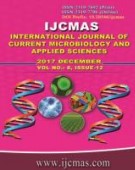


 National Academy of Agricultural Sciences (NAAS)
National Academy of Agricultural Sciences (NAAS)

|
PRINT ISSN : 2319-7692
Online ISSN : 2319-7706 Issues : 12 per year Publisher : Excellent Publishers Email : editorijcmas@gmail.com / submit@ijcmas.com Editor-in-chief: Dr.M.Prakash Index Copernicus ICV 2018: 95.39 NAAS RATING 2020: 5.38 |
A GM or transgenic crop is a crop which contains a gene or genes of a different species artificially inserted in its genome, which may come from an unrelated plant or from a completed different species. GM plants have been deliberately developed for a variety of reasons: e.g., longer shelf life, disease resistance, pest resistance, herbicide tolerance, nutritional improvement, resistance to such a biological stresses as drought or nitrogen starvation. Since GM crops were first commercialized in 1996, the planting of GM crops has consistently increased by 10% or more each year worldwide. The global hectarage of biotech crops have increased more than 100-fold from 1.7 million hectares in 1996 to over 175 million hectares in 2013 – this makes biotech crops the fastest adopted crop technology in recent history. The number and type of microorganisms inhabiting the rhizosphere of wheat were markly affected by the substitution of a chromosome pair from a variety of spring wheat relatively resistant to common root rot. Number of nematodes, collembola and ants were more in Bt plants rhizosphere as compared to non Bt plants rhizospere. The composition of microbial communities in the rhizosphere is governed by quality and quantity of carbon substrates that are released as root exudates. Targeted genetic traits for improved plant nutrition include greater plant tolerance to low Fe availability in alkaline soils, enhanced acquisition of soil inorganic and organic P, and increased assimilation of soil N.
 |
 |
 |
 |
 |